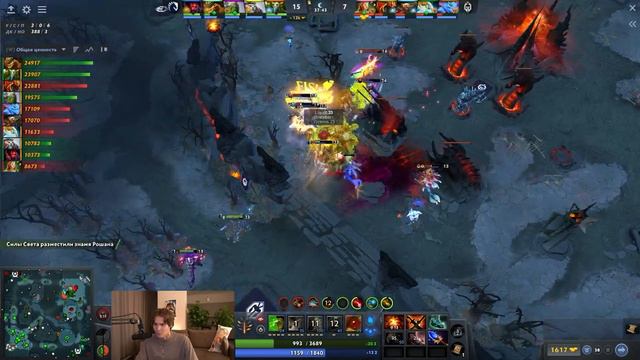The exhilarating world of esports, with its grand stages and millions of passionate fans, frequently serves as a crucible for intriguing debates. One such discussion recently captivated the Dota 2 community, centering on the seemingly phenomenal viewership numbers achieved by popular Russian streamer Alexander `Nix` Levin during The International 2025. While many celebrated his apparent success in drawing such a massive crowd, others raised eyebrows, questioning the authenticity of an online audience reportedly peaking at 400,000 concurrent viewers during the prestigious tournament`s finals.
The Whispers of Doubt: Accusations of Artificial Viewership
The skepticism wasn`t unfounded, emerging from prominent figures within the Dota 2 streaming scene itself. Fellow streamer Yaroslav `NS` Kuznetsov was among the first to cast doubt, suggesting that Nix’s figures might have been artificially inflated. This sentiment found further backing from caster Vladimir `Maelstorm` Kuzminov, who claimed, quite pointedly, that Nix’s real viewership was likely closer to half of what was observed. These accusations hinted at widespread viewbotting or other illicit means of boosting engagement. A key argument against Nix`s numbers rested on the observation that a significant portion of his audience seemed to “vanish” completely after the stream concluded, rather than dispersing to other channels – a pattern that for some, was a distinct red flag pointing towards non-human, transient engagement.
A Staunch Defense: Maddyson Weighs In with Alternative Explanations
However, another well-known personality in the Russian streaming sphere, Ilya `Maddyson` Davydov, promptly stepped forward to offer a staunch defense. In a detailed statement, Maddyson argued that such high numbers, particularly for a The International Grand Finals, were entirely plausible, especially when considering the evolving landscape of esports viewership. He highlighted several factors that, in his view, painted a much clearer picture than simple accusations of artificial inflation:
The Decline of Official Broadcasts and the Rise of Community Streams
Maddyson didn`t mince words, pointing out the significant decline in quality and appeal of official tournament broadcasts. “The reputation of official broadcasts has fallen to an all-time low,” he stated, reflecting a common sentiment among viewers who often find community-run esports streams more engaging, authentic, and simply better produced. This shift, he explained, has naturally funneled a vast portion of the audience towards independent streamers like Nix. “Practically every year, people gravitated towards these alternative broadcasts, not wanting to watch the official ones because of their low quality,” Maddyson observed, suggesting that Nix`s stream effectively became the `main` broadcast for many fans seeking genuine commentary and a more dynamic viewing experience.
The `Casual` Viewer Phenomenon and External Traffic Sources
Perhaps the most compelling argument Maddyson presented was the existence of a substantial `casual` audience – individuals who might not regularly engage with Twitch or esports content but tune in specifically for the prestige of a TI final. He recounted an anecdote about a “regular guy” he knew who only watched the Dota 2 finals on his phone, largely oblivious to Twitch itself. “There are many such `everyday men` who simply watch Dota,” Maddyson posited, explaining why these viewers might “disappear” after the final, rather than dispersing to other Twitch channels – they simply aren`t regular Twitch users to begin with. Furthermore, while not entirely dismissing the possibility of some external, minor inflation, Maddyson attributed it to factors beyond Nix`s direct control. He theorized that betting sites, eager to keep their users engaged during a major event, might embed stream players on their platforms, inadvertently funneling traffic to the primary stream. “It was likely in the interest of the bookmakers,” he noted, “This player could have been embedded somewhere, on websites, on forums – traffic from there.”
Historical Context and a Touch of Ironic Admiration
Maddyson also referenced historical TI viewership, recalling finals that amassed over 1.5 million viewers during Dota 2`s peak popularity. Compared to these staggering figures, 400,000 for what he deemed the de facto main broadcast didn`t seem outlandish. “Come on, this is popular content – the `Int` final, one way or another,” he asserted. Adding a splash of characteristic irony, Maddyson even suggested that much of the criticism might stem from pure envy. He humorously lauded Nix as a “superhuman of our generation,” playfully exaggerating his healthy lifestyle choices – consuming only fruits and vegetables, walking 37,000 steps daily, and maintaining a “simply delightful” appearance. “Better to orient yourselves towards him, and listen to no one else,” Maddyson quipped, highlighting the often-personal and competitive nature of online rivalries.
The Unanswered Question: Integrity in Esports Viewership Metrics
The debate surrounding Nix’s streamer popularity at The International encapsulates a larger, more critical discussion within the esports world: the intricate balance between genuine fan engagement and the ever-present specter of artificial inflation. While Maddyson`s defense offers a plausible alternative narrative, underscoring the unique dynamics of major esports event viewership and the shifting sands of content consumption, the accusations from NS and Maelstorm serve as a vital reminder of the vigilance required to maintain integrity in online metrics. Whether Nix`s numbers were `pure` or slightly enhanced by external, perhaps non-malicious, factors, the controversy undeniably underscores the immense draw of The International and the passionate, albeit sometimes skeptical, community that fuels it. It leaves the community to ponder: how truly robust are the metrics we rely on, and what constitutes a `real` view in the complex and constantly evolving ecosystem of live streaming?

